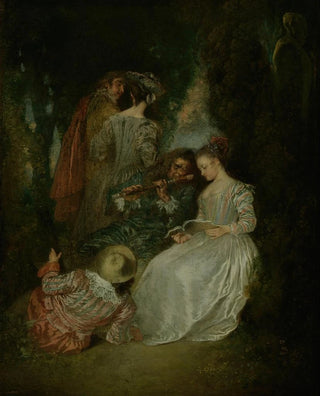Art print | The Perfect Harmony - Jean-Antoine Watteau


View from behind

Frame (optional)
The Perfect Harmony - Jean-Antoine Watteau – Captivating Introduction
The Perfect Harmony, an iconic art print by Jean-Antoine Watteau, immerses us in a universe where lightness and poetry converge. This canvas, created in the early 18th century, embodies the Rococo spirit, an artistic movement flourishing at the French court. Through this work, Watteau invites us to explore the subtleties of human relationships, capturing a fleeting moment of complicity between elegantly dressed characters. The scene, bathed in a dreamlike atmosphere, evokes the pleasures of life while hinting at underlying melancholy. The art print transports us to a world where time seems suspended, where every detail is carefully orchestrated to create visual and emotional harmony.
Style and uniqueness of the work
The art print stands out for its masterful use of color and light. Watteau, a pastel master, plays with delicate shades that give his characters an almost ethereal aura. The composition is skillfully balanced, with each element finding its place in a visual dialogue. The drapery of the costumes, with carefully studied folds, reveals the artist’s unparalleled talent for rendering movement and texture. The faces, expressive and subtle, reflect deep psychology, inviting the viewer to ponder the thoughts and emotions of the protagonists. Furthermore, the scene is enriched with symbolic details, such as musical instruments that suggest harmony not only sonically but also emotionally. This work transcends the simple genre portrait to become a true reflection on human relationships and societal games.
The artist and his influence
Jean-Antoine Watteau, a prominent figure of Rococo, left an indelible mark on art history. Born in 1684 in Valenciennes, he mastered blending classical tradition with a new sensitivity, paving the way for generations of painters. His style, characterized by unparalleled lightness and grace, influenced artists such as François Boucher and Jean-Honoré Fragonard. Watteau was also a pioneer in developing the "fête galante," a genre that celebrates

Matte finish

View from behind

Frame (optional)
The Perfect Harmony - Jean-Antoine Watteau – Captivating Introduction
The Perfect Harmony, an iconic art print by Jean-Antoine Watteau, immerses us in a universe where lightness and poetry converge. This canvas, created in the early 18th century, embodies the Rococo spirit, an artistic movement flourishing at the French court. Through this work, Watteau invites us to explore the subtleties of human relationships, capturing a fleeting moment of complicity between elegantly dressed characters. The scene, bathed in a dreamlike atmosphere, evokes the pleasures of life while hinting at underlying melancholy. The art print transports us to a world where time seems suspended, where every detail is carefully orchestrated to create visual and emotional harmony.
Style and uniqueness of the work
The art print stands out for its masterful use of color and light. Watteau, a pastel master, plays with delicate shades that give his characters an almost ethereal aura. The composition is skillfully balanced, with each element finding its place in a visual dialogue. The drapery of the costumes, with carefully studied folds, reveals the artist’s unparalleled talent for rendering movement and texture. The faces, expressive and subtle, reflect deep psychology, inviting the viewer to ponder the thoughts and emotions of the protagonists. Furthermore, the scene is enriched with symbolic details, such as musical instruments that suggest harmony not only sonically but also emotionally. This work transcends the simple genre portrait to become a true reflection on human relationships and societal games.
The artist and his influence
Jean-Antoine Watteau, a prominent figure of Rococo, left an indelible mark on art history. Born in 1684 in Valenciennes, he mastered blending classical tradition with a new sensitivity, paving the way for generations of painters. His style, characterized by unparalleled lightness and grace, influenced artists such as François Boucher and Jean-Honoré Fragonard. Watteau was also a pioneer in developing the "fête galante," a genre that celebrates






